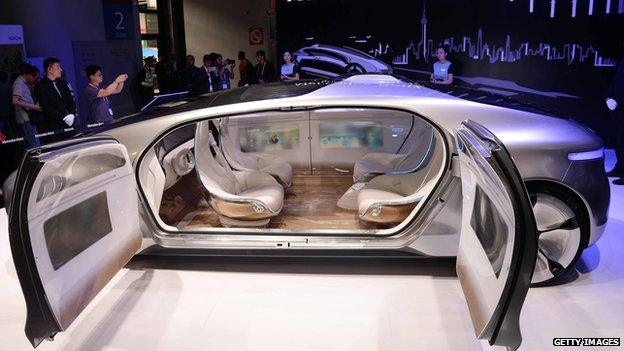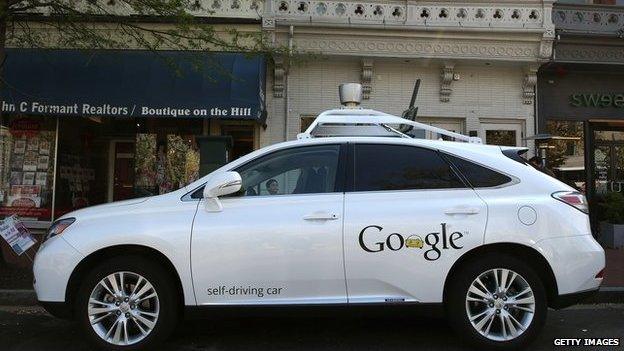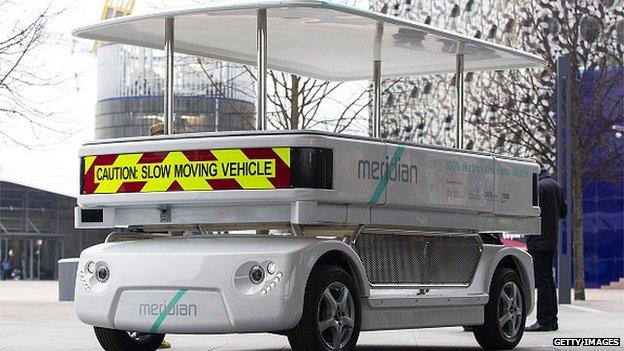Look no hands: Self-driving cars on a road near you?
- Published
- comments

In theory taking human beings out of the driver's seat altogether could cut accidents to close to zero
Close your eyes and I'll take you there is what they sang in the musical, West Side Story. Fifty-eight years later, that proposition is the promise of the 21st Century automobile.
The self-driving car has long been the stuff of science fiction. Now it may soon be here, on the streets of Britain and other places.
The British government is interested, and putting money into the proposition. Three consortia of consultants companies and universities are revving up trials in places such as Greenwich, Bristol, Coventry and Milton Keynes.
But they have some catching up to do. For the past six years, Google cars have been cruising the roads and streets of California and Texas with a human driver ready to take over from the autonomous machine in an emergency.
They have racked up more than one million miles of autonomous experience, 14 accidents (mainly being rear-ended by distracted drivers), and vast amounts of data about this sort of transport.
To outsiders it appears as if Google has cracked the future of car, and even parked one of the first prototypes in the Computer History Museum in Mountain View, Silicon Valley, California. I sat in it (static) last summer.

Google's driverless cars have already driven over one million miles
Autonomous vehicles do indeed have huge potential. In theory taking human beings out of the driver's seat altogether could cut accidents to close to zero. People who cannot drive for some reason could use car transport.
They could vastly increase the density of road use, eliminate looking for parking spaces, and then do the tricky business of parking. They could hugely reduce the cost of road transport by replacing truck drivers with computer power.
They could turn our roads into great channels of schematised connectivity with vehicles moving close together in a similar way to how information moves along the Internet's fibre optic "pipes". IT specialists are always frustrated with the random chaos of roads and motorways, now - they think - road transport is ripe for true digitalisation.
That is the vision. Getting there is difficult, like all transitions. And many different groups of people are working on it.
Legal obstacles
One of the most eye-catching schemes in Britain is in Milton Keynes, where the Autodrive Project wants to deploy a collection of small autonomous electric pods.
Arrive at the railways station, step into a two-person pod, say where you want to go (in a limited town centre range of addresses) using your smart phone, and off you drive.
The pods are designed to use the ample pavements of Milton Keynes, not the roads where autonomous vehicles are not permitted by law. The trouble is, to use powered vehicles on pavements is going to need a change in the regulations, too.

These driverless pods will go on trial on the pavements of Milton Keynes later this year
This is nothing like the drive-anywhere experience promised by the enthusiasts. It's a reminder of the Segway dilemma in Britain, imposing severe legal restrictions on a mode of personal transport heralded as revolutionary when it was introduced in 2001.
Illegal to ride a motor vehicle on the pavements, illegal on the roads too. No doubt the legal problems will be resolved for the pods.
The pods are part of the great familiarisation process that will be needed to make autonomous driving acceptable - not just to the users inside but to the people on the roads and pavements who encounter them. It's a question of trust.
What laws have to change to make this possible? What local regulations? What is the role of insurance companies in a transport world where (theoretically) the chance of accidents is reduced to almost zero by the intelligence of the computer driver?
And (big question) who has the best chance of creating a really autonomous vehicle? Existing car manufacturers or the tech upstarts trying to break into the market - people such as Google or Tesla with little or no prior investment in the internal combustion engine?
Incremental change
Looked at objectively, it will probably take a long time for full scale A-B self-driving cars to become the norm. And mingling autonomous cars with human drivers is going to be very tricky.
So look out first for self-driving trucks doing routine drives between depots, cutting the cost of lorry transport by 80% if the human driver can be eliminated.

But it could be some time before driverless vehicles like this are a regular feature on UK roads
An autonomous trial being pioneered by Volvo in Gothenberg in Sweden in 2017 gives me another vivid glimpse of the future. These cars will not go everywhere for years. But it may be relatively easy to tackle the main part of the commuting journey - the bit in the middle.
A human driver will take the car to the motorway. Then the car itself takes over allowing the commuter to read, sleep or prepare for the working day ahead.
Get close to the chaotic city, and the car will hand back to the driver - or pull in safely and wait for him or her to take over.
Meanwhile, ordinary cars are becoming a little bit autonomous piece by piece, from cruise control to assisted parking to collision warnings. They are heading towards being computers with wheels attached.
It will be decades before self-driving cars are the norm, but the bits and pieces that make them almost viable could creep up on us almost unawares - with lower insurance premiums, they say.
You can catch up with Peter Day's In Business programme on driverless cars on the BBC iPlayer and you can download the latest podcast from Peter's World of Business. The World Service edition of this programme, Global Business, will be broadcast on 8 August.